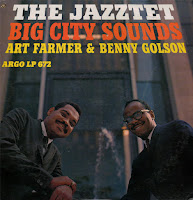Listen To The Ahmad Jamal Quintet
Released 1961
Recording and Session Information
Ahmad Jamal QuintetAhmad Jamal, pinao; Ray Crawford, guitar; Joe Kennedy, violin; Israel Crosby, bass; Vernel Fournier, drums
Chicago, August 15 & 16, 1960
10363 Who cares?
10364 Ahmad's waltz
10365 Hallelujah
10366 Tempo for two
10367 Yesterdays
10368 It's a wonderful world
10369 You came a long way from St. Louis
10370 Valentina
10371 Lover man
10372 Baia
Track Listing
| Ahmad's Waltz | Ahmad Jamal | August 15 & 16 1960 |
| Valentina | Christine, Reynolds | August 15 & 16 1960 |
| Yesterdays | Kern, Harbach | August 15 & 16 1960 |
| Tempo For Two | Joe Kennedy | August 15 & 16 1960 |
| Hallelujah | Grey, Robin, Youmans | August 15 & 16 1960 |
| It's A Wonderful World | Adamson, Savitt, Watson | August 15 & 16 1960 |
| Baia | Barroso | August 15 & 16 1960 |
| You Came A Long Way From St. Louis | Russell, Brooks | August 15 & 16 1960 |
| Lover Man | Davis, Sherman, Ramirez | August 15 & 16 1960 |
| Who Cares | George & Ira Gershwin | August 15 & 16 1960 |
Liner Notes
REMEMBER when the record people talked so incessantly about finding a "new sound?" The search went on wildly and weirdly, with tapes that were speeded and slowed and doubled back upon themselves, echo chambers and wind tunnels and bullwhips and other gimmicks. The engineers didn't say they were looking for a "good" sound—just a "new" one.The fad faded, but Ahmad Jamal fans, whose number is so great that they have snapped up tremendous volumes of the pianist's long-playing records in the last three years, will find a different kind of "new sound" on this record. It's not only new; it's good.
Ahmad has sold a schmillion LPs as the head man of a trio that long has included Israel Crosby on bass and Vernell Fournier on drums. Why, then, add violin and guitar strings to what bas been an essentially percussive and artistically and financial successful combination?
For the ample reason that there is more than one way to say a thing, more than one volume or tone of voice. Everybody knows Ahmad Jamal has something to say musically, Herewith he embellishes his message without losing the simplicity and sense of understatement that zoomed him up the ladder at an amazing rate of speed.
Ahmad's piano, Israel's bass, and Vernell's drums greet the violin of Joe Kennedy and the guitar of Ray Crawford, and you can hear them assert (in naval parlance): "Happy to have you aboard!"
The newcomers to the ensemble (and please let's not start calling it the Ahmad Jamal trio plus two) join the group gracefully. They are not obtrusive and they aren't bashful either, You'll hear them lurking in the background much of the time. When it's their turn to take the tiller, they step into poised if momentary command.
Jamal devotees may find Ahmad has put more impact and a richer flavor than usual into this first record session with a fivesome, and they're likely to agree that the added strings are a worthwhile experifilcnt. The youthful veteran continues to be a musician who speaks softly but carries a subtle wallop.
These are not just so many tunes in one mood, with a few at different tempo stuck in for contrast. They're a package filled with variety—bright or brooding, racy or reflective, carefree or cautious.
Ahmad's Waltz is a pointed exercise that has nothing in common with the three-quarter time of Johann Strauss. Jamal's piano is the captain of this cruise, but Crawford's guitar has no hesitancy about making its presence known.
Ahmad's Valentina bears slight resemblance to the young lady of that name whose praises Maurice Chevalier sang a generation ago. Fournier's virile drums make it sound more like Son Of Valentina in their heated discussion with the piano. When the violin enters it's a swinging party that grows more upbeat as it goes along.
The unhurried Yesterdays, an evergreen ideal for a reworking, gets a pensive introduction before wiggling off in several directions With the maestro's touch embroidering it elaborately.
Tempo For Two answers decisively the question: "Why the violin?" Now you know! Joe Kennedy fiddles a forthright argument before piano, drums, bass, and guitar voice their agreement in beautiful balance.
In Halleluiah, Ahmad shows how deftly he can maintain touch of delicacy even When he and his teammates are in a hurry. That violin steals brief scene again in It's A Wonderful World when, after a deep-throated bass idyll, it picks up the scene both saucily and plaintively.
Some feverish dialogue between piano and drums marks Ahmad's piano extends a tentative feeler into Memory Lane in You Came Long From St. Louis with a wistfulness that could be a recollection of the Browns of that town, but the cnsemblc jars the keyboard into today with an assertiveness that makes for a strong finish.
Lover Man is frankly sentimental, with violin courting piano to the soft voiced accompaniment of the other three. Who Cares? the venerable Gershwin gem, ends this cavalcade with a rousing romp in which each says his say in turn, almost like instrumentalists in an oleltime Dixieland band.
Yep, this session has variety. And — any more questions about why Ahmad Jamal decided to try adding a violin and guitar?
William Leonard









